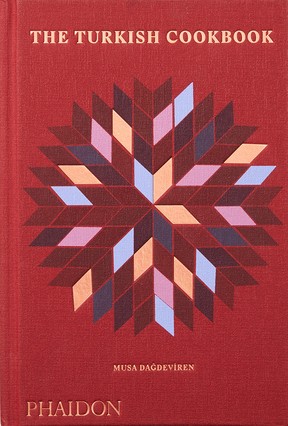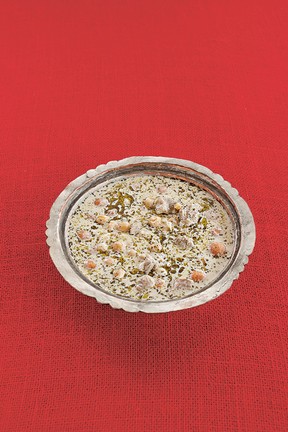“Slowly but surely, the seeds we sow for the revival of Turkish culinary traditions are growing”
Reviews and recommendations are unbiased and products are independently selected. Postmedia may earn an affiliate commission on purchases made through links on this page.
Content of the article
Our cookbook of the week is The Turkish Cookbook by Istanbul-based chef and restaurateur Musa Dağdeviren. To try a recipe from the book, check out Stuffed Bread (ekmek dolması), Festive Meatball and Chickpea Stew (tıkliye), and Burnt Milk Pudding (kazandibi).
Advertising
This ad has not loaded yet, but your article continues below.
Content of the article
Musa Dağdeviren skillfully wraps a mound of seasoned ground meat in a sheath of caulk grease. It’s ferdali, explains the Turkish chef and restaurateur in an episode of Chef’s table before proposing the local name: Perdeli, which means “curtains”. He pierces the center of the now lacy package before piercing it with a long wooden pole and repeating, stacking on top of each other with whole onions placed on either end to hold the meat in place. Finally, he places the loaded pole on embers in a brick oven to cook.

Ferdali is the forerunner of a dish now associated with Turkey all over the world. The one that takes many shapes and proportions, and which predates, by several centuries, the establishment of the republic itself: The kebab. By delving into its history and cultural context, Dağdeviren highlights the depth of the dish, which in its ubiquity can easily be taken for granted. Whether it’s a Halifax donair, slathered in its signature sweet sauce, a banh mi doner kebab – the popular Vietnamese version of Hanoi – or one of France’s favorite late-night snacks , a doner kebab stuffed with fries, there’s a lot to learn about the origins of this classic dish that has garnered plenty of spin-offs.
Advertising
This ad has not loaded yet, but your article continues below.
Content of the article
Born in Nizip, a town near the Turkish-Syrian border, Dağdeviren started cooking alongside his mother at an early age and started working in his uncle’s bakery when he was five years old. For more than 30 years, he has been reviving dying culinary traditions in his family of Çiya restaurants in Istanbul. It publishes the quarterly magazine Yemek ve Kultür ( Gastronomy and culture listen)) and runs a publishing house, Çiya Yayınları, which reprinted the first Turkish-Ottoman cookbook. Thanks to her appearance in Season 5 of the Netflix docuseries, Dağdeviren’s tireless efforts to document and preserve unsung Turkish dishes have attracted a wider audience. And with his highly sought-after new tome, The Turkish Cookbook (Phaidon, 2019), it offers an even broader insight into local eating habits.
Advertising
This ad has not loaded yet, but your article continues below.
Content of the article
Fieldwork, which laid the foundation for the book’s 550 recipes, is the “driving force” of Dağdeviren. He has spent decades traveling to villages across Turkey, visiting home kitchens, observing techniques, tools and vessels, and collecting recipes and stories. “A Turkish proverb says: ‘He who knows is not he who reads, but he who travels.’ Although I’m a big fan of reading, I really felt what our ancestors meant when I was doing the fieldwork,” he says in an email interview. “Immersion is the best way to learning; all your senses are involved and there is a deep satisfaction in feeling part of traditions and cultures that have prevailed for centuries.”
Slowly but surely, the seeds we sow for the revival of Turkish culinary traditions are growing
Moussa Dagdeviren
When Dağdeviren opened his now acclaimed restaurant Çiya Sofrası in 1998, the focus on lesser-known dishes from across the country was not immediately embraced. But when news of his comprehensive work began to spread internationally and nationally, attitudes changed: “It was like a movement, a new trend taking off.” Regional dishes, once decried, have become a source of pride. Chefs adept at French culinary techniques have begun to incorporate local techniques, he says, and old new products such as freekeh, now readily available in supermarkets, are once again pantry staples.
Advertising
This ad has not loaded yet, but your article continues below.
Content of the article
“Traditional and regional Turkish cuisine was once associated with women making gözleme behind shop windows. Çiya introduced the local palate to the fabulous diversity of our cuisine,” says Dağdeviren. “(I am) grateful that, slowly but surely, the seeds we are sowing for the revival of Turkish culinary traditions are growing. The future indeed looks very bright and that makes all the hard work worthwhile.

Regionality is in the foreground The Turkish Cookbook ; each recipe begins with its place of origin and cultural significance: in the western Aegean region of Turkey, ekmek dolması (stuffed bread) is a popular dish during the Muslim holy month of Ramadan (May 5 to June 4, 2019); in the southeastern region of Anatolia, tıkliye (festive stew of meatballs and chickpeas) is “the star of iftar tables” (the evening meal that breaks the Ramadan fast); and kazandibi (burnt milk pudding), now a popular dessert across the country, was created in the kitchens of Istanbul. As with his work at Çiya, Dağdeviren’s choice to focus on food as a product of the peoples of a specific region rather than ethnicity was deliberate.
Advertising
This ad has not loaded yet, but your article continues below.
Content of the article
“You can’t explain food in nationalistic terms, using geography is the only way. A nationalistic approach to food will only impoverish any given food culture. You make it insular. We need to discuss the connection between food and the region and culture it grows in,” says Dağdeviren. “Food is not a national entity, it is geographical. Some dishes are prepared on special occasions by different faith communities, such as dishes prepared for Lent. Assigning a nationality to dishes – calling them Kurdish, Turkish, Armenian, Rum (Ottoman Greek), Assyrian or Arabic – will not unite us but will divide us. Cultures are passed down through people. I do my part by owning, by propagating and transmitting the culinary culture of my own geography.
Advertising
This ad has not loaded yet, but your article continues below.


